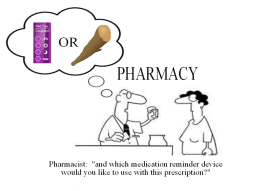MORS and SMORS — more than a sweet treat
I’m going out on a limb here and betting many of you have not heard of MORS and SMORS. For your information, they may be one of the best solutions around to improve medication adherence, compliance and patient safety.
Medication Organizer Reminder Systems MORS and Secure Medication Organizer Reminder Systems SMORS are a group of products designed to organize patient medications and provide audible and/or visual alerts to remind patients to take their medication on time, every time.
My interest in MORS and SMORS, (which always reminds me of a good time around a campfire), began nearly three years ago when I first started researching medication adherence and compliance.
when I first started researching medication adherence and compliance.
Although the causes and proposed solutions to the medication adherence/compliance problem vary widely and are often debated, it seems one thing can be agreed upon by all… it is a very costly healthcare problem in the U.S. today. The cost of non-adherence was estimated to be $290 billion annually by the New England Healthcare Institute NEHI in 2009. It’s now estimated by some to be in the neighborhood of $330 billion or more annually.
When you add in the additional costs of adverse drug reactions, medication misuse, lack of control of diseases like hypertension, diabetes, etc., additional physician, hospital and emergency department visits, this figure approaches nearly a half trillion dollars annually. And this does not even take into consideration the loss of life from inappropriate medication use estimated to be over 125,000 deaths annually.
MORS and SMORS can help patients improve their medication compliance which in turn will improve control of their particular disease and reduce healthcare costs in the long run.
Opening doors for pharmacists —
I recently presented information on April 17th, 2013, to the Oregon Board of Pharmacy on the topic of medication adherence and compliance, the costs associated with the problem and the patient safety issues that arise when patients don’t take medications as prescribed. Pharmacists need to understand and utilize the available technology, including MORS and SMORS, to improve patient outcomes and help reduce healthcare costs.
But at this time the Oregon BOP does not allow pharmacists to dispense, fill or set up medications for use in medication organizer reminder systems. Pharmacy rules for medication labeling and packaging currently prevent pharmacists from doing so as they are not compliant with Board rules and guidelines. Several other states, including neighboring Washington State, have moved forward and adopted rules to allow pharmacists to utilize this technology to improve patient care and safety.
The Board responded favorably to my request by proposing additions to the customized patient medication packaging rule (Oregon 855-041-1140) to provide a waiver for approved medication organizer reminders systems not meeting regular labeling and packaging guidelines. After the recent rulemaking hearing, the Board will now move forward and vote on the new rule and, hopefully, implement this change in Oregon pharmacy law at their August 2013 meeting.
Patient safety is the issue —
The proposed rule change is based on improving patient safety as well as improving medication adherence. Allowing pharmacists to be involved with filling or dispensing medications for use in medication organizer reminder systems will have a positive impact on medication adherence, compliance and medication safety. Do you see the opportunity for pharmacists here?
The real solution —
The impact of the proposed rule changes are not based solely on the use of medication organizer reminder systems. The real solution to the adherence dilemma is getting pharmacists involved with their patients.
A recent report published by the National Community Pharmacy Association NCPA identified what I believe to be the biggest factor for combating the medication adherence problem:
- The biggest predictor of medication adherence was patients’ personal connection (or lack thereof) with a pharmacist or pharmacy staff. Patients of independent community pharmacies reported the highest level of personal connection (89 percent agreeing that pharmacist or staff “knows you pretty well”), followed by large chains (67 percent) and mail order (36 percent).
“This predicting factor was followed in order of importance by: affordability of medications; continuity in health care usage; how important patients feel it is to take their medication as prescribed; how well informed they feel about their health; and medication side effects.”
Enter here… The Door is OPEN —
The door is now open for pharmacists to seize this opportunity to get involved with medication organizer reminder systems and assist their patients who may be struggling with medication adherence problems.
It’s the perfect addition to patient counseling or medication therapy management MTM to improve patient medication compliance and patient safety.
If your state Board of Pharmacy rules need to be changed for you to get involved, you need to BE THE CHANGE. Address the topic with your state Board and urge them to move the profession of pharmacy forward.
Feel free to contact me for assistance and advice on how to move forward with this in your state.
- Either leave a comment on this blog page
- Follow me and direct message me on Twitter @drwalker_rph
- email me directly at drwalkerrph@gmail.com


